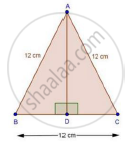Advertisements
Advertisements
Question
Calculate the height of an equilateral triangle each of whose sides measures 12 cm.
Solution

We have,
ΔABC is an equilateral Δ with side 12 cm.
Draw AE ⊥ BC
In ΔABD and ΔACD
∠ADB = ∠ADC [Each 90°]
AB = AC [Each 12 cm]
AD = AD [Common]
Then, ΔABD ≅ ΔACD [By RHS condition]
∴ AD2 + BD2 = AB2
⇒ AD2 + 62 = 122
⇒ AD2 = 144 − 36 = 108
⇒ AD = `sqrt`108 = 10.39 cm
APPEARS IN
RELATED QUESTIONS
In an isosceles triangle ABC, AB = AC = 25 cm, BC = 14 cm. Calculate the altitude from A on BC.
Each side of a rhombus is 10 cm. If one of its diagonals is 16 cm find the length of the other diagonal.
In a right ∆ABC right-angled at C, if D is the mid-point of BC, prove that BC2 = 4(AD2 − AC2).
Find the length of the altitude of an equilateral triangle of side 2a cm.
ΔABC~ΔDEF such that ar(ΔABC) = 64 cm2 and ar(ΔDEF) = `169cm^2`. If BC = 4cm, find EF.
Find the length of each side of a rhombus are 40 cm and 42 cm. find the length of each side of the rhombus.
The co-ordinates of the points A, B and C are (6, 3), (−3, 5) and (4, −2) respectively. P(x, y) is any point in the plane. Show that \[\frac{ar\left( ∆ PBC \right)}{ar\left( ∆ ABC \right)} = \left| \frac{x + y - 2}{7} \right|\]
From given figure, In ∆ABC, AB ⊥ BC, AB = BC, AC = `2sqrt(2)` then l (AB) = ?
A girl walks 200m towards East and then 150m towards North. The distance of the girl from the starting point is ______.
In a ΔABC, ∠CAB is an obtuse angle. P is the circumcentre of ∆ABC. Prove that ∠CAB – ∠PBC = 90°.
